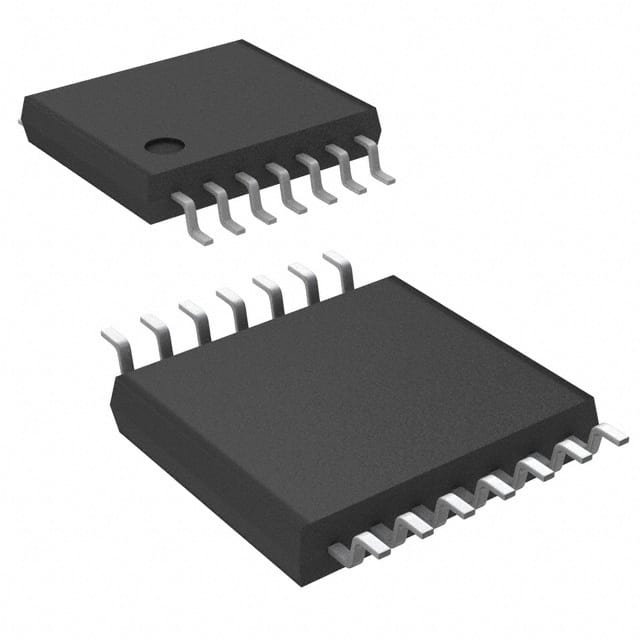Lihat spesifikasi untuk detail produk.

MC14541BDTR2G
Product Overview
- Category: Integrated Circuit
- Use: Digital Counter/Divider
- Characteristics: High-speed operation, low power consumption
- Package: SOIC (Small Outline Integrated Circuit)
- Essence: Binary counter with asynchronous reset
- Packaging/Quantity: Tape and Reel, 2500 units per reel
Specifications
- Supply Voltage Range: 3V to 18V
- Maximum Clock Frequency: 10 MHz
- Number of Stages: 4-bit binary counter
- Operating Temperature Range: -40°C to +85°C
- Output Current: ±6 mA
- Input Voltage Range: 0V to VDD
Detailed Pin Configuration
The MC14541BDTR2G has a total of 16 pins. The pin configuration is as follows:
- MR (Master Reset)
- CP (Clock Pulse)
- Q0 (Output 0)
- Q1 (Output 1)
- Q2 (Output 2)
- Q3 (Output 3)
- GND (Ground)
- VDD (Supply Voltage)
- NC (No Connection)
- NC (No Connection)
- NC (No Connection)
- NC (No Connection)
- NC (No Connection)
- NC (No Connection)
- NC (No Connection)
- NC (No Connection)
Functional Features
- Asynchronous Master Reset (MR) input allows resetting the counter to zero.
- Clock Pulse (CP) input triggers the counter to increment by one on each rising edge.
- Four output pins (Q0-Q3) provide the binary count value.
Advantages and Disadvantages
Advantages: - High-speed operation enables efficient counting in various applications. - Low power consumption makes it suitable for battery-powered devices. - Small package size allows for space-saving integration.
Disadvantages: - Limited number of stages (4-bit) restricts the maximum count value. - Lack of additional features limits its versatility in complex applications.
Working Principles
The MC14541BDTR2G is a synchronous counter that operates based on clock pulses. When a rising edge is detected on the Clock Pulse (CP) input, the counter increments by one. The binary count value is represented on the output pins (Q0-Q3). The counter can be reset to zero using the Master Reset (MR) input.
Detailed Application Field Plans
The MC14541BDTR2G is commonly used in various digital applications, including:
- Frequency Division: Dividing an input frequency by a specific factor.
- Time Delay Generation: Generating precise time delays in circuits.
- Event Counting: Counting the occurrence of specific events.
- Digital Displays: Driving LED or LCD displays with binary counting.
Detailed and Complete Alternative Models
Some alternative models that offer similar functionality to the MC14541BDTR2G are:
- CD4017BE: Decade Counter/Divider with 10 decoded outputs.
- SN74LS93N: 4-bit Binary Counter with asynchronous reset.
- HEF4020BP: 14-stage Binary Ripple Counter with internal oscillator.
These alternatives provide different features and specifications, allowing users to choose the most suitable option for their specific requirements.
Word count: 399 words
Sebutkan 10 pertanyaan dan jawaban umum terkait penerapan MC14541BDTR2G dalam solusi teknis
Sure! Here are 10 common questions and answers related to the application of MC14541BDTR2G in technical solutions:
Question: What is MC14541BDTR2G?
Answer: MC14541BDTR2G is a CMOS programmable timer/counter integrated circuit (IC) that can be used in various technical applications.Question: What is the operating voltage range for MC14541BDTR2G?
Answer: The operating voltage range for MC14541BDTR2G is typically between 3V and 18V.Question: Can MC14541BDTR2G be used as a timer?
Answer: Yes, MC14541BDTR2G can be used as a timer by configuring its internal registers and connecting external components.Question: How many timing modes does MC14541BDTR2G support?
Answer: MC14541BDTR2G supports three timing modes: monostable (one-shot), astable (free-running), and bistable (flip-flop).Question: What is the maximum frequency output of MC14541BDTR2G?
Answer: The maximum frequency output of MC14541BDTR2G is typically around 2 MHz.Question: Can MC14541BDTR2G be used in battery-powered applications?
Answer: Yes, MC14541BDTR2G can be used in battery-powered applications as it operates within a wide voltage range.Question: Does MC14541BDTR2G have any built-in debounce feature?
Answer: No, MC14541BDTR2G does not have a built-in debounce feature. External debouncing may be required for certain applications.Question: Can MC14541BDTR2G be used as a frequency divider?
Answer: Yes, MC14541BDTR2G can be used as a frequency divider by configuring its internal registers accordingly.Question: What is the typical power consumption of MC14541BDTR2G?
Answer: The typical power consumption of MC14541BDTR2G is relatively low, making it suitable for battery-powered applications.Question: Are there any application notes or reference designs available for MC14541BDTR2G?
Answer: Yes, the manufacturer provides application notes and reference designs that can help in understanding and implementing MC14541BDTR2G in various technical solutions.
Please note that the answers provided here are general and may vary depending on specific use cases and requirements. It's always recommended to refer to the datasheet and application notes provided by the manufacturer for detailed information.

